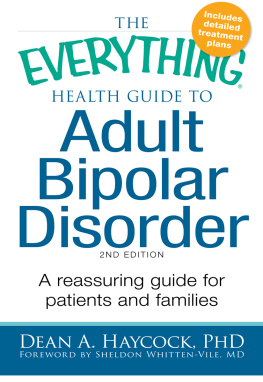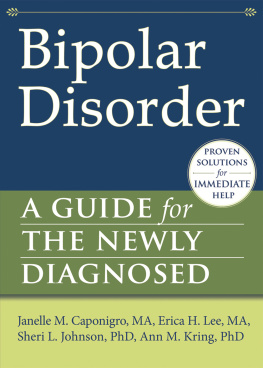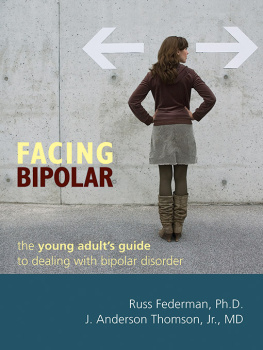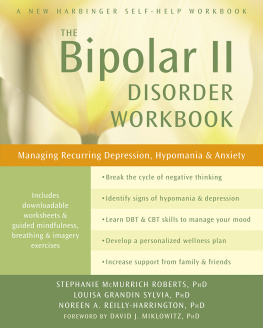Kerrie Eyers is a psychologist, teacher and editor with many years experience in mental health. She is the Publications Consultant at the Black Dog Institute, Sydney, and is editor of Tracking the Black Dog (UNSW Press, 2006).
Gordon Parker is Professor of Psychiatry at the University of New South Wales and Executive Director of the Black Dog Institute. He is a renowned researcher with over 30 years experience with mood disorders, and is author of Dealing with Depression: A common sense guide to mood disorders (Allen & Unwin, 2004).
Tessa Wigney, Kerrie Eyers and Gordon Parker are co-editors of Journeys with the Black Dog: Inspirational stories of bringing depression to heel (Allen & Unwin, 2007).
www.blackdoginstitute.org.au
MASTERING
BIPOLAR
DISORDER
An insiders guide to managing
mood swings and finding balance
Edited by
KERRIE EYERS & GORDON PARKER

First published in 2008
Copyright Black Dog Institute 2008
All rights reserved. No part of this book may be reproduced or transmitted in any form or by any means, electronic or mechanical, including photocopying, recording or by any information storage and retrieval system, without prior permission in writing from the publisher. The Australian Copyright Act 1968 (the Act) allows a maximum of one chapter or 10 per cent of this book, whichever is the greater, to be photocopied by any educational institution for its educational purposes provided that the educational institution (or body that administers it) has given a remuneration notice to Copyright Agency Limited (CAL) under the Act.
Allen & Unwin
83 Alexander Street
Crows Nest NSW 2065
Australia
Phone: (61 2) 8425 0100
Fax: (61 2) 9906 2218
Email: info@allenandunwin.com
Web: www.allenandunwin.com
National Library of Australia
Cataloguing-in-Publication entry:
Mastering bipolar disorder: an insiders guide to managing mood swings and finding balance/editors, Kerrie Eyers; Gordon Parker.
ISBN 978 1 74175 546 6 (pbk.)
Bibliography.
Manic-depressive illness.
Eyers, Kerrie.
Parker, Gordon, 1942
616.895
Text and cover artwork by Matthew Johnstone
Text design by Lisa White
Set in 10.5/14 pt Bembo by Midland Typesetters, Australia
Printed in Australia by McPhersons Printing Group
10 9 8 7 6 5 4 3 2 1
CONTENTS
FOREWORD
I begin to wonder
if Ill soar too high and break like thunder
through the sanity barrier.
Or will I plummet in the other direction
and be buried in the ground
till resurrection? (62)
This book takes the reader into the world of those who have bipolar disorder. In their stories, they have shared their wisdom about managing this most difficult condition, wisdom that can be summarised:
Like most illnesses, bipolar disorder affects people from all walks of life; it is free of prejudice and merciless in its execution. But thats not to say it cannot be managed successfully. (127)
Bipolar I Disorderonce termed manic depressive illnessaffects up to 1 per cent of the population. Left untreated, it is a severe and chronic condition defined by oscillating episodes of mania (highs) and depression. During the manic episodes the individual can become psychotic and experience delusions and hallucinations.
Bipolar II Disorder has gained increasing recognition in the last decade. It is often seen as a less severe expression of bipolar disorder. The individual experiences non-psychotic highs (hypomania) that oscillate with depression. This disorder has a much higher prevalence than Bipolar I Disorder, affecting up to 5 per cent of the population over their lifetime. Hypomania often goes unrecognised, as most individuals enjoy the mood elevation and only seek help for the depression that so often follows. This can, unfortunately, lead to many years of misdiagnosis and under-treatment.
What are the causes of bipolar disorder? The bipolar disorders are not just personality styles, but biologically-mediated conditions, reflecting genetic factors underpinned by changes in brain neurotransmitters. While we once used the term cyclothymia to describe the personality style of individuals whose general mood alternated from cheerful and vivacious to glum and mildly depressed, the bipolar disorders are more than this: they are categorically abnormal mood states.
What are some signs? In general, during a bipolar high the individual experiences enhanced energy and mood: feeling wired, creative, and extremely confident and elated (I am privy to a Godseye view of the world (173)), although for many, feelings of anger and irritability may dominate. There is little need for sleep; he or she is tireless. They talk moreand overpeople, are loud, rash in conversation and behaviour, buy whatever takes their fancy, and are often sexually disinhibited. Previous anxiety or shyness melts away.
Mugged by happiness, one writer observes:
I actually believed that no-one on earth could be as happy as me... Tears streamed from my eyes as I began each day. (112)
But then...
If there is an upside to maniaand there isthere is absolutely no upside to depression. None. Depression is very often fatal and it causes untold suffering. For that reason alone, everything possible should be done to prevent mania. (54)
The depression usually follows as the elevated mood ebbs away. Feelings now are the converse: low mood, low energy. Self-worth evaporates, people feel black and hopeless, lose motivation, avoid others and have a profound sense of anhedoniaan inability to experience any pleasure. Good news or happy events cannot cheer them, and they lose the light in their eyes. Concentration is painfully impaired and, for most, every movement is slowed, particularly in the morning. Many are wrung by agitation during depressive episodes, and wake early with a churning feeling, tortured by restlessness.
Reaching a diagnosis of bipolar disorder involves clinical review of symptoms over the years. The individual will often report a distinct onset (usually in adolescence or early twenties) which differentiates the condition from personality style diagnoses, or from other clinical conditions such as Attention Deficit Hyperactivity Disorder (ADHD). The accuracy of the diagnosis is greatly helped by corroborative information from an observer, be they friend or relative.
Advice on how to manage bipolar disorder has been disseminated by professionals for more than two thousand years. The most definitive current information about Bipolar I Disorder is to be found in Goodwin and Jamisons 1990 book, Manic-Depressive Illness. Kay Redfield Jamison, an author of that classic work, has also evocatively described her own experience of the illness in her very readable book An Unquiet Mind (1995). In addition, many psychiatric associations have published treatment guidelines for managing Bipolar I Disorder. However, while many research papers have been published about Bipolar II Disorder, the first book considering this condition alone only appeared as recently as 2008 (Parker, 2008).
Professional recommendations for managing the bipolar disorders generally see medication as a given to stabilise the condition and regain balance. Additional benefits are added by education about the disorder, counselling and support strategies. Advice from health care professionals has the authority of evidence that is gathered from scientific studies and clinical trials. However, mental health literacy studies indicate that the best tactics for management are not necessarily agreed on between professionals, consumers and the general public. Thus, in addition to outside in professional advice, we also need and benefit from inside out advice. Sharing the often painfully acquired wisdom of those who have bipolar disorder and who have trialled all sorts of strategies may be of use for others to weave into their own personal safety nets. Hence this book.
Next page









